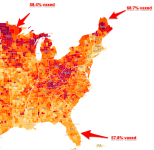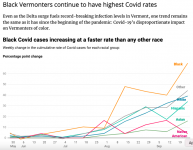Huh. Odd how this tidbit from a tiny nation known as "India," with a population barely over a billion people, has basically been ignored.
Remember how India was being crushed by the Delta variant? India responded not only with the vaccine - now less doses administered than the total number of people in the country, i.e., on average less than one dose per resident - but also implemented widespread Ivermectin + Doxycycline (an antibiotic) use to treat patients infected with the Chinese flu.
Uttar Pradesh might sound obscure to most Americans, but it is the most populated state in India, with urban areas that rival the most densely populated cities in the U.S. Yet, miraculously, despite housing a population of 240 million people, this northern state has been averaging only 24 cases...

www.theblaze.com
The result? India has seen a MASSIVE drop in mortality due to the Chinese flu. How low? As of October 5, 2021 a seven-day average of 255 deaths per day in a nation of more than a billion people.
ArcGIS Dashboards

www.arcgis.com
So I am interested in a possible explanation other than the widespread use of Ivermectin + Doxycycline on infected patients. Seriously, let's try and figure this out.
Because India is less densely populated than the United States? Uhh, no.
Because India has better sanitation than the United States? Yeah, no.
Because India has better healthcare than the United States? Uhh, no, no, no.
Because India has a higher number of vaccinated than the United States? Yeah, no, not even close. India has 18.6% fully vaccinated, not even a third of the total in the United States
So what gives? Seriously, why is the mortality rate in a densely populated, generally filthy nation with an incredibly low vaccination rate so low?
Other than Ivermectin + Doxycycline, I mean, since the WHO told us Ivermectin was not to be used to treat the Chinese flu.










/https://tf-cmsv2-smithsonianmag-media.s3.amazonaws.com/filer_public/7f/48/7f48971a-8f28-4310-ad60-3e4bef46a16b/unvaccinated_individuals.png)